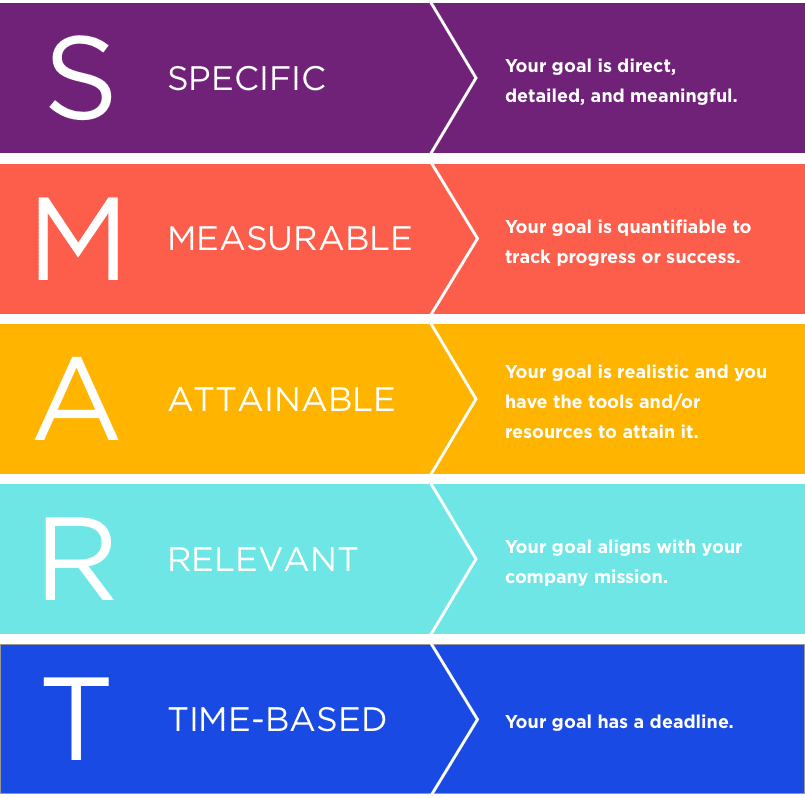Table of Contents
What are SMART goals? A SMART goal is a goal that is Specific, Measurable, Attainable, Relevant, and Time-Based.
Goal setting is a necessary component for success in the workplace. Goals go beyond simply boosting employee productivity: They give us purpose and help us turn our aspirations into reality.
But if the power of setting goals at work has been proven time and time again, then why is it that 60% of businesses say they don’t have a standard goal-setting method in place?1
Most companies don’t know where to start when it comes to setting and defining expectations. And if you’re a part of the statistic? Don’t worry — we workplace nerds have got you. Today, let’s focus on a fan favorite: SMART goals.
What is a SMART goal?
A SMART goal is a goal-setting method first introduced in 1981 by George Doran, Arthur Miller, and James Cunningham. In the article, “There’s a S.M.A.R.T. Way to Write Management Goals and Objectives,” the authors introduce the SMART acronym and its criteria:

- Specific goals are direct, detailed, and meaningful.
- Measurable goals are quantifiable and can be tracked to monitor progress or success.
- Attainable goals are realistic and require employees to have the tools or resources to achieve them.
- Relevant goals align with your company mission and will push a business forward.
- Time-based goals have a definite time frame and a completion date.
The purpose of the SMART methodology is to provide a template to help you write actionable, achievable goals in an organized fashion. And it’s done just that. Since its debut, the SMART goal system has become popular across the globe, and variations of the acronym have developed over the decades.
How to set SMART goals
Each element of the SMART acronym adds crucial value to the goal. Address each component separately before piecing them together.
Specific
The first step in the SMART goal setting process is to be as specific as possible with your goal.
We recommend addressing the 5 Ws when making a goal specific: why, what, when, who, where. (Sound familiar? The 5 Ws are used by journalists to focus their intentions before they craft stories.)
Questions to consider when writing specific goals
- What do I want to achieve?
- When do I want to accomplish this goal?
- Who needs to be included to complete this goal?
Measurable
It’s important to know how to measure SMART goals. Goal tracking is a vital part of the goal-setting process. This keeps teams accountable for measuring the progress, success, or failure of their goals.
By identifying Key Performance Indicators (KPIs) during the early stages of setting SMART goals at work, you’ll be able to measure the short- and long-term progress of your goals over time.
Questions to consider when writing measurable goals
- What metrics will I use to track this goal?
- Are there multiple ways to measure success for this goal?
- What quantifiable change to the business am I hoping to achieve by accomplishing my goals?
Remember, some goals take longer than others to show results, which is why choosing the right metrics matter.
Attainable
The most compelling goals push us out of our comfort zones and encourage us to grow. But they also need to be realistic.
For example, it’s commendable if your goal is to increase ad revenue by 100%, but impossible to accomplish if you don’t have the budget or time to dedicate to testing.
Questions to consider when writing attainable goals
- Do I have the tools and/or resources I need to complete this goal?
- Do I have the skill set to accomplish this goal?
- Is this goal possible, and if so, what is my action plan?
Relevant
If your goal isn’t directly connected to the work you’re doing, it’s probably not a good goal. And on a higher level, if it’s not aligned to your company’s mission statement, then it can be hard to understand the meaningful impact of your work.
(You can review goal types, and their relationships, in our Definitive Guide to Setting Goals at Work.)
Questions to consider when writing relevant goals
- Does the goal align with my overarching company objective?
- Does this goal make sense with our business plan?
- Will accomplishing this goal move my business forward?
Time-based
Your goal can be specific, measurable, attainable, and relevant — but it’s all trivial if your goal isn’t time-bound.
Imagine you own a synthetic Christmas tree store, and your goal is to sell 325 trees to people within a 50-mile radius of your shop. You have the necessary equipment and inventory to accomplish the goal, it aligns with your company mission, and you can easily track your success. The only problem is it’s the middle of summer, and very few people are shopping for Christmas trees.
Timing really is everything.
Questions to consider when writing time-bound goals
- When will I complete the goal?
- What target dates should I meet to complete the goal?
- Should I set this goal now or in a later quarter?
Goal tips, examples, and more:
Setting Goals at Work: The Definitive Guide
SMART goal example
Okay, let’s put this theory into practice. For this SMART goal example, let’s say our goal is to increase the number of leads we generate.
Here’s how we can turn this into a SMART goal.
- Specific — The sales and marketing teams, together, will generate 30 new leads through an email nurture campaign dedicated to prospects in the healthcare industry.
- Measurable — We will track the number of leads closed as well as email engagement to measure the success of our campaign.
- Attainable — We have an email marketing program, a list of prospects, and a dedicated driver with time for this project.
- Relevant — This supports our company mission to provide better project management software to the healthcare industry.
- Timely — We will roll this email campaign out over a 4-week period starting on July 28th. Emails will be sent on Tuesdays, and we will continue to track the success of our emails for a 6-week period.
How to use SMART goals to work
Now that you know what SMART goals are, here’s how you can use them to drive success at work.
Collaborate with teammates
Encourage your team members to set their own SMART goals and discuss them with their coworkers. SMART goals have an even greater chance of success when they’re supported by teammates. Remember, feedback is crucial to individual and company success.
Track goals with performance management software
There’s nothing worse than setting and forgetting your goals! All of your progress goes out the window if you don’t know how to accurately assess it.
A Goals & Feedback platform like WorkTango can equip your team with the tools it needs to set and track goals in real time across teams and departments.
Reward teams for hitting SMART goals
Companies that use employee incentive programs report a 79% success rate in achieving their established goals when the correct reward is offered.2 That’s because recognition and rewards fuel our desire to do well, and make us all more engaged with work when done well.
Make goals a part of the conversation, year round.
6 Reasons Why You Should Set Quarterly Goals

Downloadable resource: Goal-setting worksheet
Start with clear intention: Write your goals down! People who write down their goals have an 80% higher chance of achieving them than those who don’t.
That’s why we created a downloadable SMART goals worksheet to help you document, categorize, and set your goals. You can use this planning worksheet for both short-term and long-term goals as you plan monthly goals or tackle daily to-do lists.
Let this serve as your action plan to ensure you’ve thought about every angle of your SMART goals — ensuring they are specific, measurable, attainable, relevant, and time-based.
Bonus points? Our goal worksheet also comes with a section dedicated to OKRs to truly take your personal and business goals to the next level.
→ Download our goal-setting worksheet to write your SMART goals
SMART goals vs. OKRs
Speaking of OKRs — let’s take a minute to address what SMART goals can’t do for you. (And why with the right mindset, that doesn’t matter!)
SMART goals are a great place to start the goal-setting process. But they can fall short when it comes to expressing creativity and ambition. That’s because SMART goals are tactical by nature and focus on a 100% success rate. This means they can stifle more innovative projects.
That’s where the OKR method steps in.
OKRs stand for Objectives and Key Results. The OKR goal-setting method, which was made famous by Google, takes SMART goals to the next level. These goals are set by determining the high-level objective first, then orienting all lower level action items toward achieving that objective. OKRs are also designed to be stretch goals. That means, unlike with their attainable SMART counterparts, accomplishing 60-70% of an OKR is deemed a success.
To put it simply, SMART goals are a formula for writing effective goals, and OKRs align these goals to organizational and departmental goals.
To put it simply, SMART goals are a formula for writing effective goals, and OKRs align these goals to organizational and departmental goals.
That’s right. SMART goals and OKRs work together — even more powerfully – in conjunction.
So let’s put an end to the “SMART goals vs. OKRs” debate. It’s a false dichotomy. Companies that limit themselves to one goaling method are missing the whole picture. The important takeaway here is to make sure that you have some form of a standardized goal setting method in place and a way to document it.
Setting SMART goals with WorkTango
Going for the goal with WorkTango
There’s no doubt about it: Goals are essential for leveling up your employees – and your business’ success. And WorkTango makes it even easier.




